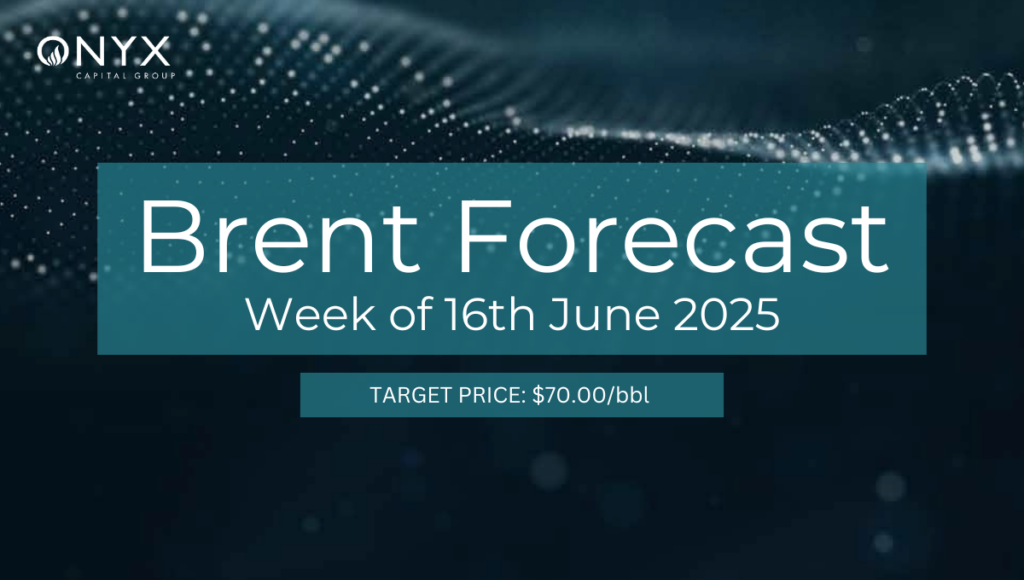Brent forecast – Geopolitical special
Iran has rejected truce talks while under attack, refusing to negotiate until it has completed its response to Israel’s strikes. This is the fourth day of open warfare, and the line in the sand around oil infrastructure has been broken. The strikes have been on domestic infrastructure as opposed to exports, with missile and drone strikes on Iranian refining facilities, oil fields and gas fields. Iranian ballistic missile reportedly hits the Haifa refinery in Israel, retaliating against Israel’s strikes on Iranian energy and nuclear sites.
Israel has destroyed Iran’s allies, the ones willing to fight them, anyway, and Israel has a rich and supportive friend in the US. All steps taken in this war have been careful, with high-ranking Iranian officials precisely assassinated rather than their surroundings carpet-bombed, which shows control from Israel. Each step that risks oil infrastructure damage and price spikes also risks America’s support. Trump has warned that continued war would risk the continuation of US support to Israel. Trump has been clear from his second inauguration: “My proudest legacy will be that of a peacemaker and unifier”. US backing of Israel, however, has been unwavering and escalating as tanker tracking systems show that there has been proof of Arleigh Burke-class guided-missile destroyers from the US Navy, likely positioned in the Eastern Mediterranean. The deployment of KC-135 and KC-46 tankers to Europe for DEFENDER 25 and the upcoming NATO summit likely supports Eastern European operations. However, with recent B-52H activity in the Middle East, these tankers could pivot quickly if needed. President Trump has encouraged the two countries to make a deal, and the power of any leak or Truth Social post regarding withdrawing funds to Israel would likely encourage a sell-off. In the event of greater pressure on prices, $71/bbl was a continued support level in the low volatility, rangebound prices in Q4’24. It seems unlikely that there may be enough pressure in this environment for the contract to drop to fill the gap-up, as this would mean breaking through the psychological $70.00/bbl level.
Analysts and commentators seem to agree that it is ‘impossible’ for Iran to close the Strait of Hormuz. This seems beside the point, as deciding that Iran can’t physically block the Strait seems beside the point. The real impact of Iranian attacks on shipping lies less in physically closing the Strait of Hormuz and more in how insurers and shipping companies respond. Historical and current examples, such as the ongoing Houthi attacks in the Red Sea and the Iran-Iraq Tanker War, show that elevated war risk premiums, rather than actual disruptions, drive route. Given the lack of alternative routes out of the AG, major global powers, most importantly to Iran, China, are unlikely to accept a closure of this critical chokepoint. It will only alienate its neighbours, who rely vastly on petrodollars. This does not, however, discount any action by a third party or smaller group of non-government-endorsed fighters, either acting clandestinely on behalf of Iran, or from their own volition, to make the Strait too dangerous to insure boats through which would have a similar bullish effect. This could allow for the M1 Brent to revisit 2025’s high of over $82.50/bbl, where it met resistance in Jan.
There seems to be a red line in attacking solely the domestic energy supply chain. Passing this would likely mean a target on Kharg Island. This terminal processes almost all of Iran’s oil exports. The vulnerability of Kharg was underscored in the Iran-Iraq war, with exports likely dropping to less than 1mb/d from over 2.5mb/d. This was before the 1988 Brent futures creation, but good spare capacity elsewhere cushioned spot pricing. There continues to be quite strong spare capacity, from Saudi Arabia and the UAE especially, but this blatant risk of massive spikes in volatility and upside would be a problem for US support, given the explicit aim of low energy prices from the Trump administration. If Kharg Island is attacked, we expect a significant jump in prices, due to players buying into the media rhetoric which has focused on Kharg and genuine barrels at risk.

Source: ICE, Onyx Capital Advisory
Brent may have seen accelerated support due to a potential gamma squeeze, which occurs in options markets, as players have been short liquidity and as liquidity shot up from 13 Jun, players needed to cover their short position by buying the futures contract. There may also have been support from options players closing their positions, with significant drops in $60 put and $70 call open interest. This is likely profit taking from $70 calls and a reduction in downside risk from $60 puts. Looking at the open interest of Brent, there is significant open interest at $90 calls. 13 Jun saw a significant increase in $80 and $90 calls. This follows a few weeks of the $55 put seeing a higher OI.

Source: ICE, Onyx Capital Advisory
These key psychological levels that we see particularly high OI may cause a liquidation event or gamma squeeze.

Source: ICE, Onyx Capital Advisory
Looking at Onyx’s in-house net positioning model, net positioning in Brent has risen to almost flat. This likely means that the sell-side liquidity from CTAs has risen, as net positioning has risen from very short, where it may not have been possible to sell from. This opens greater sell-side risk, but is not necessarily bearish, as positioning is neutral.
It seems at the moment, neither Iran nor Israel is interested in risking a significant oil supply. Therefore, we expect this downward slide to continue this week, to settle around $70.00/bbl. However, it is important to remain vigilant to the more extreme scenarios, and not to discount the unlikely as impossible.
#OilWar #MiddleEastConflict #IranIsrael #BrentCrude #EnergyGeopolitics #OilMarketRisk #CrudeVolatility #EnergySecurity






